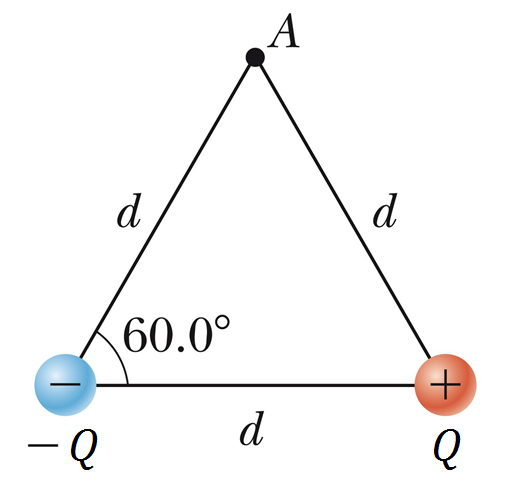
College Physics
11th Edition
ISBN: 9781305952300
Author: Raymond A. Serway, Chris Vuille
Publisher: Cengage Learning
expand_more
expand_more
format_list_bulleted
Concept explainers
Question
Consider the charges -Q and Q at two vertices of an equilateral triangle separated by d = 2.0 cm, as shown in the figure below. For Q = 18 pC, calculate the magnitude of the electric field (in N/C) at point A. Round your answer to 2 decimal places.

Transcribed Image Text:d
d
60.0°
-Q
Expert Solution
This question has been solved!
Explore an expertly crafted, step-by-step solution for a thorough understanding of key concepts.
Step by stepSolved in 2 steps with 2 images

Knowledge Booster
Learn more about
Need a deep-dive on the concept behind this application? Look no further. Learn more about this topic, physics and related others by exploring similar questions and additional content below.Similar questions
- Given a charge Q1=50nC located at the XY coordinates (5m, 10m) and a charge Q2= -20nC located at the X, coordinates (-3m.-1m). The field point has coordinates (-3m, 4m). Find the Total Efield?arrow_forwardYou have the same line of charge in the previous problem (with +6.00 nC of charge on it). But now you are measuring the electric field 1.5 m above the center of the rod – see image below. Predict the electric field at Point P in this diagram. Make sure to include a direction with your answer.arrow_forwardA thin rod is bent into a half circle of radius R and centered on the y-axis so that it lies flat in the xy-plane as indicated in the diagram. This glass rod is rubbed all over with silk so that the rod has a total positive charge Q uniformly distributed over the length of the bent rod. Answer the following questions to determine the net electric field at an observation location A located on the positive z-axis a distance d from the origin. (See pic 1 for the following questions) A. Consider an infinitesimal piece of the glass rod located at an angle θ\thetaθ from the positive x-axis. Determine the relative position vector that points from this piece of the rod to the observation location. B. Derive an expression for the electric field dE⃗ of the infinitesimal piece dQ located at angle θ and integrate over the charge distribution to determine the net electric field E⃗ at the observation location. Your answer should only contain the given variables (R, Q, d) and known…arrow_forward
- Please Asaparrow_forwardShown in the figure below is a collection of two charges labeled as q, and q2. Also labeled is the "Point P", which is where we will do our calculations. To understand the notation, please note the following: not to scale y 9₁ (0, V₂) Item Charge (C) P P (0, y₂) The vector E means the electric field at P due only to gr The vector E means the electric field at P due only to q The vector Er means the total electric field at P due to all charges (x,y) m (0.00,5.62) None q1 -7.41e-06 (0.00, -1.56) q2 4.28e-06 (2.56, 2.94) 9₂ (x₂, V₂) Determine the distance from q; to P: r₁= Determine the distance from q₂ to P: r₂-arrow_forwardFind the electric field at P in the figure shown below. (Take r = 1.9 m and ? = 37°. Measure the angle counterclockwise from the positive x-axis.) magnitude direction °arrow_forward
arrow_back_ios
arrow_forward_ios
Recommended textbooks for you
 College PhysicsPhysicsISBN:9781305952300Author:Raymond A. Serway, Chris VuillePublisher:Cengage Learning
College PhysicsPhysicsISBN:9781305952300Author:Raymond A. Serway, Chris VuillePublisher:Cengage Learning University Physics (14th Edition)PhysicsISBN:9780133969290Author:Hugh D. Young, Roger A. FreedmanPublisher:PEARSON
University Physics (14th Edition)PhysicsISBN:9780133969290Author:Hugh D. Young, Roger A. FreedmanPublisher:PEARSON Introduction To Quantum MechanicsPhysicsISBN:9781107189638Author:Griffiths, David J., Schroeter, Darrell F.Publisher:Cambridge University Press
Introduction To Quantum MechanicsPhysicsISBN:9781107189638Author:Griffiths, David J., Schroeter, Darrell F.Publisher:Cambridge University Press Physics for Scientists and EngineersPhysicsISBN:9781337553278Author:Raymond A. Serway, John W. JewettPublisher:Cengage Learning
Physics for Scientists and EngineersPhysicsISBN:9781337553278Author:Raymond A. Serway, John W. JewettPublisher:Cengage Learning Lecture- Tutorials for Introductory AstronomyPhysicsISBN:9780321820464Author:Edward E. Prather, Tim P. Slater, Jeff P. Adams, Gina BrissendenPublisher:Addison-Wesley
Lecture- Tutorials for Introductory AstronomyPhysicsISBN:9780321820464Author:Edward E. Prather, Tim P. Slater, Jeff P. Adams, Gina BrissendenPublisher:Addison-Wesley College Physics: A Strategic Approach (4th Editio...PhysicsISBN:9780134609034Author:Randall D. Knight (Professor Emeritus), Brian Jones, Stuart FieldPublisher:PEARSON
College Physics: A Strategic Approach (4th Editio...PhysicsISBN:9780134609034Author:Randall D. Knight (Professor Emeritus), Brian Jones, Stuart FieldPublisher:PEARSON

College Physics
Physics
ISBN:9781305952300
Author:Raymond A. Serway, Chris Vuille
Publisher:Cengage Learning

University Physics (14th Edition)
Physics
ISBN:9780133969290
Author:Hugh D. Young, Roger A. Freedman
Publisher:PEARSON

Introduction To Quantum Mechanics
Physics
ISBN:9781107189638
Author:Griffiths, David J., Schroeter, Darrell F.
Publisher:Cambridge University Press

Physics for Scientists and Engineers
Physics
ISBN:9781337553278
Author:Raymond A. Serway, John W. Jewett
Publisher:Cengage Learning

Lecture- Tutorials for Introductory Astronomy
Physics
ISBN:9780321820464
Author:Edward E. Prather, Tim P. Slater, Jeff P. Adams, Gina Brissenden
Publisher:Addison-Wesley

College Physics: A Strategic Approach (4th Editio...
Physics
ISBN:9780134609034
Author:Randall D. Knight (Professor Emeritus), Brian Jones, Stuart Field
Publisher:PEARSON